
Uncategorized
All Hilled Up
I am hilling these potatoes as they grow. The mound they are in is now about two feet (60cm) above the garden bed level. I planted the seed potatoes in the garden bed and as the stems grew, I moved some compost and kept pushing it up around them. The compost is fairly light and not compacted at all which should make it quite easy for potatoes to grow into it. That’s the theory. Time will tell if it is successful or not.
The dripper lines are at the bottom where the seed potatos were planted. I figured that the compost on top would prevent evaporation and that any excess moisture would probably wick up through the mound.
Harvest Time
Potatos are harvested after flowering and when the tops have died off. Commercial growers usually spray the potatoes with a herbicide to kill the tops and make them wither. They find it easier to harvest if the top growth has all withered and shrivelled. It makes it easier on their machinery if they don’t have any fibrous material clogging it up. It also means that they can harvest earlier than if they waited for the tops to die naturally. You just don’t know how many chemicals you are ingesting when you rely solely on out food suppliers.

Uncategorized
Remember the instant trellis.
Now it is the angled luffa green wall.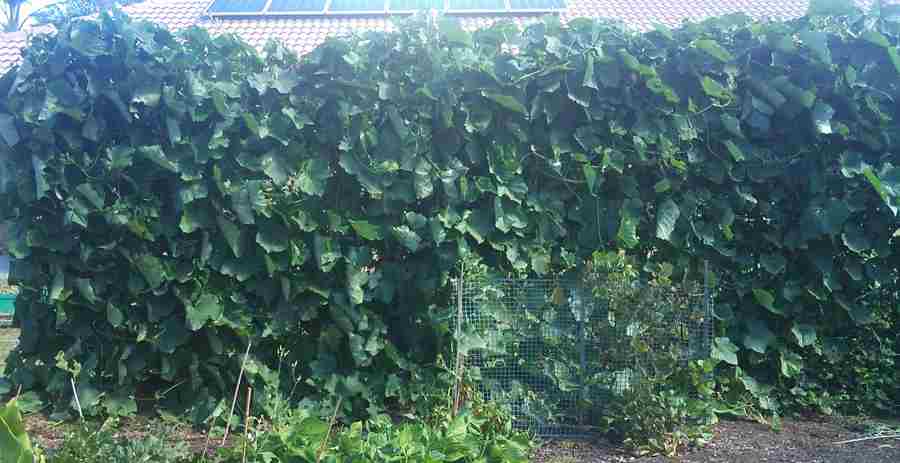
The house behind it hadn’t started being built when I took the photo of the instant trellis.
I have had some angled luffa seeds for a couple of years now purchased from Green Harvest. The packet said best sown before Sept 2016. I was waiting for the trellis.
Notes from the packet
Synonym – Okra Cee Gwa. Okra Vine is fast growing and vigorous. The flavour of the young fruit is similar to zucchini but slightly sweeter, it is a good substitute in humid areas as it does not suffer fungal problems. The stem tops, young leaves and flower buds can also be steamed as vegetables and the seeds from mature fruit roasted with salt and eaten.
I can vouch that it is a vigorous grower. As well as the luffa, I planted some winged bean and New Guinea bean against the trellis, which is 6 metres long. The luffa has smothered both of the other vines and grows so quickly that pruning it is a lost cause.
Because the seeds were old I planted at least six of them. They all germinated and went beserk. I soaked them overnight before planting.
These luffa are just a couple that I picked. I hadn’t checked the vine for two days as all I had been seeing were small luffa that didn’t seem to be growing. I’d find a small fruit but thought it was dropping off before growing to maturity. Looks like I was wrong and they were hiding.
The big ones in the picture are over 60cm in length (two feet) in the old scale. The smaller one is in with dinner tonight. 
The Angled Luffa Taste Test

I chopped the smaller luffa of the three pictured into bite sized bits. They were placed in a microwave container with a few drops of water and sprinkled with some rock salt.
Microwaved for two minutes. They were Zucchini like on the inside with a little bit of crunchy texture on the outside that wasn’t at all stringy. Very edible and in my opinion a little bit of a soy bean flavour. Well worth growing in sub-tropical Brisbane.
What have we learnt on the show tonight Craig
Only grow one vine. If more than two seeds germinate, be ruthless. I am looking forward to trying the roasted seeds of mature luffa. Will do an update then.
Uncategorized
 Yes, I know nearly everyone calls them egg plants. But have a think about it for a minute. I am talking about the fruit that is on the plant. So what would that be? Egg plant fruit? Hence, I call them egg fruit. Have a look at this Lebanese egg plant. Hasn’t it got some fruit on it. I planted it four months ago and have already picked twenty fruit. This is the second flush.
Yes, I know nearly everyone calls them egg plants. But have a think about it for a minute. I am talking about the fruit that is on the plant. So what would that be? Egg plant fruit? Hence, I call them egg fruit. Have a look at this Lebanese egg plant. Hasn’t it got some fruit on it. I planted it four months ago and have already picked twenty fruit. This is the second flush.
 As always when you grow vegetables without using chemicals to suppress the insects it takes a while to work out what grows well in your area and how much insect damage is too much. In the picture to the left you just might see the little diabolical that is causing the holes in the leaves. Look for a grasshopper. He’s sitting on the leaf to the right of the cluster of egg fruit. And while this grasshopper, along with all of his mates is having a bean feast on the egg plant, in turn he is becoming food for a couple of different birds.
As always when you grow vegetables without using chemicals to suppress the insects it takes a while to work out what grows well in your area and how much insect damage is too much. In the picture to the left you just might see the little diabolical that is causing the holes in the leaves. Look for a grasshopper. He’s sitting on the leaf to the right of the cluster of egg fruit. And while this grasshopper, along with all of his mates is having a bean feast on the egg plant, in turn he is becoming food for a couple of different birds.
Organic Gardens encourage birds and predatory insects
I am pleasantly surprised to have a magpie patrolling the garden and rounding up grasshoppers. What surprised me more was the mynah bird that also targets them.
 The idea of organic gardening is to create an environment where the plants can grow without the need of chemicals. When it comes to pests, you want to encourage the predators like lady birds, hover flies and lacewings. Letting plants go to seed will encourage them to visit and stay. Notice the two ladybirds in the top right corner of the picture above.
The idea of organic gardening is to create an environment where the plants can grow without the need of chemicals. When it comes to pests, you want to encourage the predators like lady birds, hover flies and lacewings. Letting plants go to seed will encourage them to visit and stay. Notice the two ladybirds in the top right corner of the picture above.
The last time I grew egg plant, I had the best plants you had ever seen, but very few egg fruit. I had 200 plants and I sent about 4 x 10kg boxes to market. This time I reckon I will pick that much off this one plant.
I didn’t think it would grow this well so didn’t bother tying it up or staking it. The weight of the fruit is pulling the branches to the ground. I can only attribute this to the amount of organic matter in my garden beds and the cracker dust I add also the rock dust. It has been quite hot, which helps with egg plants and we have had regular rain. I have a dripper system as well.
Needless to say I am pleased with this. All I have to do now is find the perfect recipe.
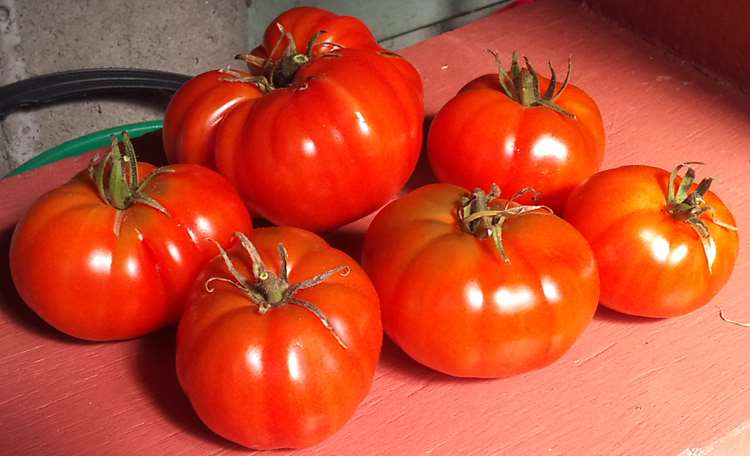
Uncategorized

Nothing beats fresh picked tomatoes
Tomatoes would have to be close to the favourite fruit I like to grow. Nothing beats looking after a tomato bush and looking forward to picking them. The distinctive aroma that is transferred to your hands when you touch them to tie them up can’t be beaten, imho.
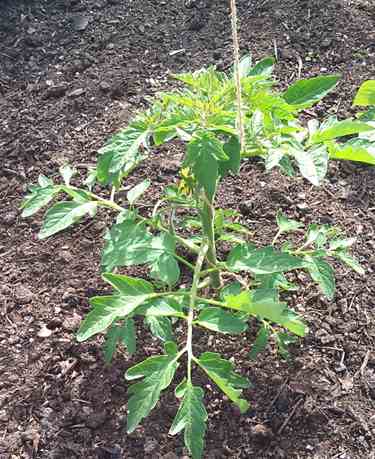
Tying up a young tomato plant
The best way I have found to grow tomatoes is to grow them in an environment that restricts insect attack and to tie them up on a string.
This young Black Russian tomato plant is being grown in the wicking bed and is protected from insect damage by a frame covered in fruit fly mesh. Notice the string winding around the stem of the plant. As the plant grows you wind it around the string to support the plant.
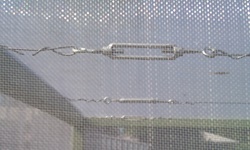
Turnbuckle to keep wire taut
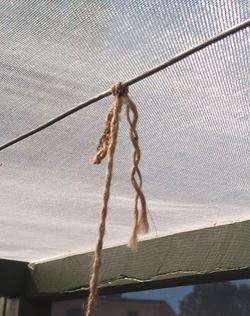
Once your supporting wire is in place, a simple slip knot is used to attach the string.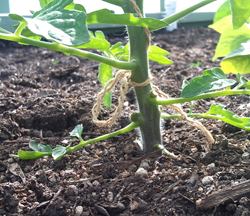

Wind the string down around the plant to the base. Make a loop and pull it back behind the string and the pressure from the wind will hold it in place. As the plant grows all you need to do is wind the tomato around the string.
There are a couple of tricks to look out for. The first one is if you have a number of tomatoe plants it helps to wind them the same way. It will depend on if you are left or right orientated whether you wind them clockwise or anti. Try one way and if it feels funny or awkward try winding the other way.
Tomatoes are bullet proof.
If you can grow your tomatoes in a protected environment your will find that tying up tomatoes makes them a gardener’s best friend. They are practically bullet proof. Even if you break them they will surprise you by growing another leader that produces tomatoes.
Recap
- Get your support wire in place
- Plant your tomato seedlings
- Drop your supporting strings from the wire
- About four weeks after planting seedlings it is time to tie them up
- Wind the tomatoes and prune on a weekly basis depending on weather conditions (longer in winter)
Now that your tomatoes are tied up, the next information needed is pruning and winding. Probably next week.
Uncategorized
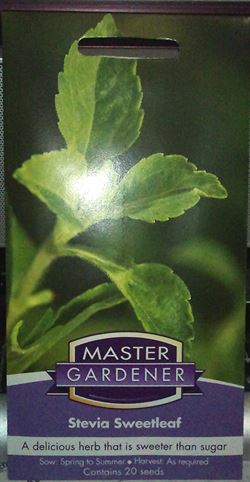
Front of the seed packet received from Mr Fothergill’s Seeds
You may recall that I was trying to grow some Stevia from seed. See this post on Stevia. I was using a seed propagating cup from Mr. Fothergill’s Seeds that they had marketed for children as the Lolly Plant.
I followed all the directions and made sure that I didn’t over water but no sign of seed germination. After about a month I sent an email to the seed company.
Hi, I purchased a couple of the lolly plant growing kits and have had no luck getting the seeds to sprout or grow. They were planted on April 29. I write a bit of a blog and what I did is noted here.https://farm54.com/stevia I haven’t overwatered. The temperature is still quite warm here so I was wondering if you could give me a few tips and maybe send some more seed so that I can have another crack at it. cheers
Prompt reply from Mr Fothergill’s Seeds
We are sorry to hear about your recent disappointment with our Stevia (lolly plant seeds); given you seem to have done everything correctly, its difficult to know exactly what may have gone wrong.
We will arrange to send you some fresh seed to try again.
Regards
Allison

The back of the packet shows that the seeds should be sown in Spring and Summer Brisbane
I received the seeds about a week ago and I noted on the back of the packet the recommended sowing time in the blue area is Spring and Summer. It may have been too cool or the wrong amount of light in Brisbane to make the seed germinate. There are 20 seeds in the packet. I will have another go at germination after the Winter Equinox on the 22nd of June and if that fails, will wait for Spring to try again.
I was quite impressed with the response and interest shown by Mr Fothergills Seed’s.

Uncategorized
A couple of months ago I had a bit of a whinge about tree roots invading the garden. see – Tree Roots and Wicking Beds

Some of the trees only metres from my garden
I felt a bit guilty

Mixed Feelings


Oh! Mr Hart, What A Mess
In case you don’t know what the caption refers to, go here – https://www.youtube.com/watch?v=8qb4n8yc2so
They were trees next door. Can’t stop progress. Not much else to say really.

 It is difficult for the potato to flourish in heavy clay soil. If this is your soil, you are better off to grow them in big mounds, or hay bales above the ground. Search for a copy of Esther Dean’s No Dig Gardening.
It is difficult for the potato to flourish in heavy clay soil. If this is your soil, you are better off to grow them in big mounds, or hay bales above the ground. Search for a copy of Esther Dean’s No Dig Gardening.
























